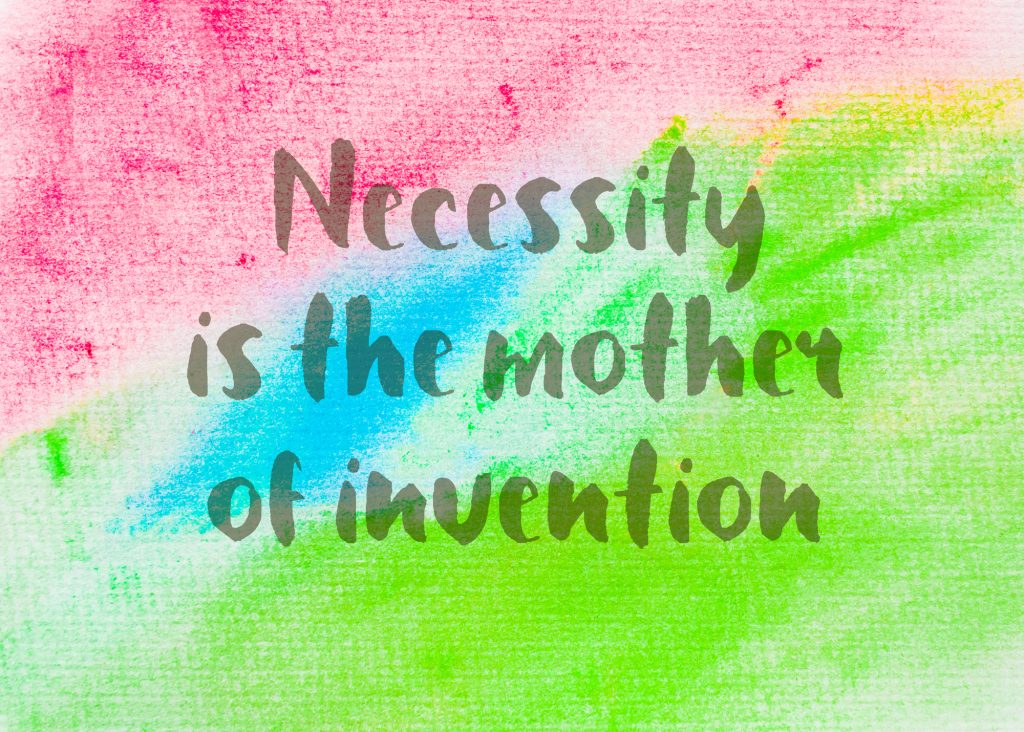The Coronavirus pandemic has forced most of us to adjust to unprecedented changes and constraints. There’s no doubt that several of these changes are unwelcome. Some of us are dealing with various forms of loss, something that I discussed in this previous blog post on dealing with ‘Pandemic Grief’. Many of us are also navigating new home versus work boundaries.
 While it is important to acknowledge that our new necessities are often frustrating and unpleasant, there is also a potential upside. It’s counter-intuitive, but we can make the most of these restrictions and let them fuel our creativity and innovation. On a personal level, this means figuring out ways to survive and ideally thrive, both personally and professionally.
While it is important to acknowledge that our new necessities are often frustrating and unpleasant, there is also a potential upside. It’s counter-intuitive, but we can make the most of these restrictions and let them fuel our creativity and innovation. On a personal level, this means figuring out ways to survive and ideally thrive, both personally and professionally.
There is a proven link between creativity and constraints. According to psychologists, when you have less to work with, you actually begin to see the world differently. Obstacles can broaden your perception and open up your thinking processes. Consistent constraints help you improve at connecting unrelated ideas and concepts. They can also help you to use existing resources in new and unanticipated ways.
In our current pandemic context, being obligated to physically distance and shelter in place, we’re being forced to see a lot of things differently. We’re re-imagining what’s possible and whether we’ve noticed it or not, we’re becoming more resourceful. We need to be.
Some examples that I’ve heard of recently include ad-hoc ‘stand-up desks’ made from various objects that we have around the house because real stand-up desks are on backorder or cost more than we want to pay.
How about the creativity it takes to carve out multiple work and study areas to accommodate everyone in the household?
A special shout out for creativity has to go to school teachers, who have had to figure out how to teach and manage their classroom remotely. Another shout out goes to parents who have figured out how to support their children’s’ remote learning while also meeting their work obligations.
 Work aside, we’re all trying to come up with new ways to celebrate birthdays and key holidays while respecting physical distancing guidelines.
Work aside, we’re all trying to come up with new ways to celebrate birthdays and key holidays while respecting physical distancing guidelines.
Creativity and Constraints Can Bring Out Your Best
In her book, “Creativity from Constraints: The Psychology of Breakthrough,” author Patricia Stokes reasons that “highly creative individuals are comfortable being highly variable.”
According to Stokes, the transition from master to creator comes when the expert imposes novel constraints on their domains.
A 2015 study examined how thinking about scarcity and abundance influences how creatively people use their resources. The Johns Hopkins researchers found basically that people in situations of abundance have no incentive to re-think ways of using what is available.
Don’t hide from a challenge. Embrace it and work with it. You may be amazed at the outcome of your creative pursuits if you make the most of the obstacles.
 On a personal level, I know that this has been my experience. The challenges of single parenting after divorce seems to have re-wired my mind. The problem-solving muscles that I developed during that period of my life carried over to what I was able to accomplish professionally as a Work Psychologist. After founding I/O Advisory Services, the consistent constraints associated with being a bootstrapping entrepreneur helped me to get even better at connecting unrelated ideas and concepts.
On a personal level, I know that this has been my experience. The challenges of single parenting after divorce seems to have re-wired my mind. The problem-solving muscles that I developed during that period of my life carried over to what I was able to accomplish professionally as a Work Psychologist. After founding I/O Advisory Services, the consistent constraints associated with being a bootstrapping entrepreneur helped me to get even better at connecting unrelated ideas and concepts.
Finding the internal resources to embrace both your creativity and constraints will serve you well when things at work return to normal or at least to the new normal. In many organizations, following the lockdown, we’ll need to compensate for lost revenue and/or smaller profit margins. This may mean doing more with less. This may also mean doing similar things differently. I’m foreseeing much more collaborative work and more inclusive workplaces since we’ll really need all hands on deck.
If you’d like to discuss this topic further, you may reach out via direct message through Twitter, Facebook, or LinkedIn to learn more or book a free initial phone consultation.
You may also call me directly at 613-424-8689 or 1-888-878-8861 or send an email to helen@ioadvisory.com to discuss my career, executive coaching, or HR services.
More than career coaching, it’s career psychology®.
I/O Advisory Services – Building Resilient Careers and Organizations.™




